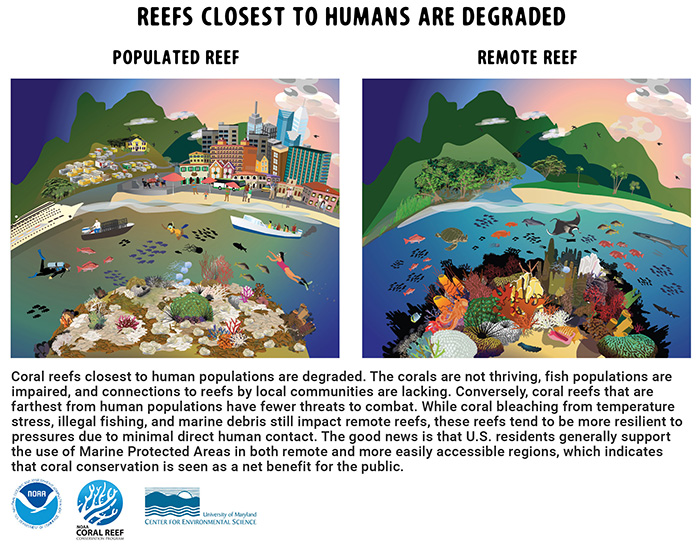- ABOUT US
- PROGRAM AREAS
- CONSERVATION APPROACH
- EDUCATION
- MULTIMEDIA
Reefs Closest to Humans are Degraded
This infographic compares a reef near a populated location to a reef in a remote area.
This infographic was made in collaboration with the University of Maryland Center for Environmental Science Integration and Application Network.
Visit the National Coral Reef Monitoring Program's page for all U.S. coral reef status reports.

Download the PDF.
Infographic Transcript: Reefs Closest to Humans are Degraded
Coral reefs closest to human populations are degraded. The corals are not thriving, fish populations are impaired, and connections to reefs by local communities are lacking. Conversely, coral reefs that are farthest from human populations have fewer threats to combat. While coral bleaching from temperature stress, illegal fishing, and marine debris still impact remote reefs, these reefs tend to be more resilient to pressures due to minimal direct human contact. The good news is that U.S. residents generally support the use of Marine Protected Areas in both remote and more easily accessible regions, which indicates that coral conservation is seen as a net benefit for the public.
About Us

The NOAA Coral Reef Conservation Program was established in 2000 by the Coral Reef Conservation Act. Headquartered in Silver Spring, Maryland, the program is part of NOAA's Office for Coastal Management.

The Coral Reef Information System (CoRIS) is the program's information portal that provides access to NOAA coral reef data and products.
Work With US
U.S. Coral Reef Task Force
Funding Opportunities
Employment
Fellowship Program
Contracting Assistance
Graphic Identifier
Featured Stories Archive

Access the archive of featured stories here...
Feedback
Thank you for visiting NOAA’s Coral Reef Conservation Program online. Please take our website satisfaction survey. We welcome your ideas, comments, and feedback. Questions? Email coralreef@noaa.gov.
Stay Connected
Contact Us
NOAA’s Coral Reef Conservation Program
SSMC4, 10th Floor
1305 East West Highway
Silver Spring, MD 20910
coralreef@noaa.gov
